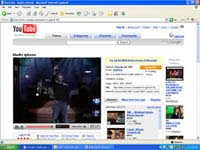 I thought I’d wake up this morning to reports flooding the Internet of smiling customers with their nifty new iPhone. I was sadly disappointed to discover that it isn’t going to hit U.S. stores until 6 p.m. tonight. Wow, does Apple ever know how to drag out suspense: better than any reality TV show ever made!
I thought I’d wake up this morning to reports flooding the Internet of smiling customers with their nifty new iPhone. I was sadly disappointed to discover that it isn’t going to hit U.S. stores until 6 p.m. tonight. Wow, does Apple ever know how to drag out suspense: better than any reality TV show ever made!For those who have to work their regular 9-5 job today, it’s good news. Or not. ABC News reporter Gene Lewis says he’s been in line at a NYC Apple store since yesterday, and is still only 53rd on the list. His last report as I write this, written at about 6 a.m. this morning, estimates that there’s about 180 people in line. I don’t even want to think of what the line will look like come 5 p.m. tonight! Apple says the purchase limit is two devices per person (why not one?); and, for the lucky few who get their hands on one, the company will hold free workshops on how to get the most out of the device starting tomorrow morning.
All U.S. Apple stores will remain open until midnight tonight; but my guess is this will serve little purpose, as the iPhone will probably be sold out before the stores even reach the end of their lines. In other words: don’t think you’ll be able to strut into an Apple store around 11:30 p.m. and magically grab one off the shelf!
ABC’s Lewis humorously refers to the iPhone as the “Jesus phone” in his play-by-play coverage (which is worth a read just to hear the reactions the people in line are getting from passers-by). This reminds me of a hilarious skit I saw on MAD TV a few months ago where cast member Mike McDonald portrayed Steve Jobs introducing the iPhone to a highly reactive, cult-like, audience. The idea was to make it look like Jobs was being worshipped as some sort of evangelist. It’ll give you a good laugh as we gear up for the actual introduction of this highly-anticipated device.
The 4 GB model will be available for US$500; and the 8 GB for US$600.





 The Associated Press reports that the head of Sony Computer Entertainment Inc., Ken Kuturagi, has stepped down, or rather “retired”. This isn’t surprising, given the fierce competition that the firm has been facing since its latest incarnation, the PlayStation 3, hit the market.
The Associated Press reports that the head of Sony Computer Entertainment Inc., Ken Kuturagi, has stepped down, or rather “retired”. This isn’t surprising, given the fierce competition that the firm has been facing since its latest incarnation, the PlayStation 3, hit the market.








